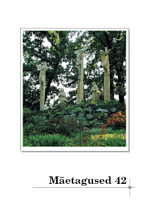Määratledes ennast suulises esituses. Äänisvepsa naise itk oma mehe haual
The Lament of Onega-Veps Woman on the Grave of Her Husband
Author(s): Alla Lašmanova, Madis ArukaskSubject(s): Customs / Folklore
Published by: Eesti Kirjandusmuuseum
Keywords: genre; laments; North-Russian cultural region; oral tradition; Orthodox folk culture
Summary/Abstract: In July 2005, while conducting fieldwork in Russian Karelia, we found ourselves in an abandoned forest village of Yashozero where we encountered the last native inhabitant of this place - an almost 80 years old Veps woman Maria. She lived without electricity, because the Soviet planned economy had declared the village non-perspective decades ago and it had been abandoned, step-by-step, because of that. Maria stayed alive owing to a nearby privately-owned hunting center, the keepers of which took care of her. Maria had almost no chance to talk to anyone but herself and the people buried to the village cemetery. Her husband had passed away one year before our visit. Maria’s relationship with her dead husband could be described as active and bilateral: Maria commemorated him in her laments and remembered in the surrounding artifacts, while the husband appeared to her in dreams and for Maria also in nighttime sounds in the house. Nevertheless, there was no doubt that her life with her husband had been harmonious and happy, and his death had come as a shock. Their son and Maria’s parents were also buried on the village cemetery. Maria’s relationship with the deceased could be also characterized by the fact that half a year before, their daughter, who had lived in the city, had died and was buried away from her home village. This article focuses on a performance which took place at noon on 11 July 2005 at the lake-side cemetery in a summer heat of 30 degrees during around half an hour. Maria lamented to her husband in Russian. Although Maria spoke the Veps language as well as a native speaker, their home language had been Russian, as Maria’s husband had been Russian. The preformed text is rich in archaic words and concepts common to the so-called epical laments of northern Russia. At the same time the text contains a lot of personal and biographical information. Maria’s viewpoint is shifting between this world and the other, between collective values and her personal miseries. The lament is more a one-sided dialogue than a monologue. It is possible to point out three different features in the lament as a performance. (1) Lament is addressed to the person residing in the grave. At the same time the lamenter defines oneself as a person on the edge - her senses are extremely responsive to the perspective beyond the grave as well as (2) to personal life and the problems linked to it. These two perspectives alternate and sometimes almost rival in Maria’s lament text. The transitions can be quite labile and their compositional background seemed to be based on individual preferences. (3) The third perspective of a lament is the sense of surroundings derived from the real situation or, more accurately, from other people currently at the cemetery. In the lamenting situation it was possible to notice Maria’s ability to switch from the poetic recitative of a lament to regular speech, from the other side and/or personal orientation to current reality.
Journal: Mäetagused. Hüperajakiri
- Issue Year: 2009
- Issue No: 42
- Page Range: 55-76
- Page Count: 22
- Language: Estonian

